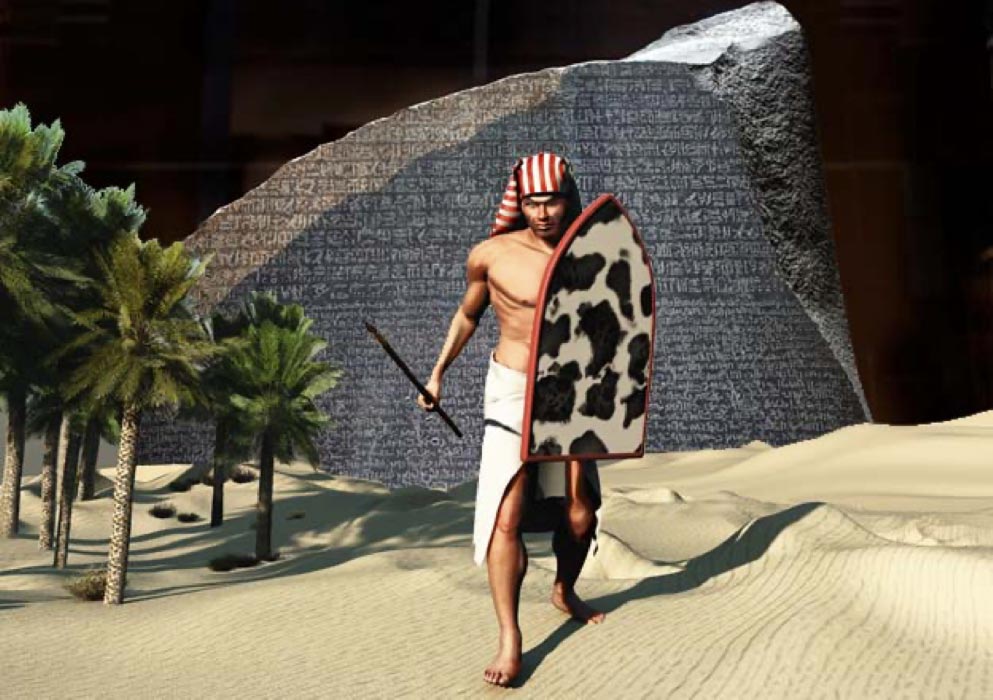Warrior’s Beat Up Body Confirms Rosetta Stone’s Message
A team of archaeologists have excavated the 2,200-year-old remains of a warrior slain in the ancient Egyptian uprising described on the famous Rosetta Stone.
On November 22 this year, at the annual meeting of the American Schools of Oriental Research (ASOR), a research team led by Dr. Robert Littman from the University of Hawaii at Manoa, and anthropological archaeologist Jay Silverstein of the University of Tyumen in Russia, announced the discovery of the skeleton at the ancient city of Thmouis, in the Mendes-Thmuis district of the Nile Delta, around 40 miles (64.38 km) from the Mediterranean coast.

The warrior’s remains were unearthed at a site in the Nile Delta and are believed to represent a casualty of an Egyptian revolt around 2,200 years ago, researchers say. (R. Littman and J. Silverstein)
He Was Definitely a Scrapper…
The word “Thmuis” means “new land” and the city was first founded around the middle of the first millennium BC as an industrial suburb. Ancient Thmuis is today buried beneath Tell Timai, a massive artificial mound of earth and debris formed through long periods of occupation and abandonment.
But it was once situated upon an important trade corridor connecting the Mediterranean Sea with Upper Egypt and it was famed in antiquity for its production of top quality perfumes.
- The father of Egyptology suffered a tragic death after deciphering the Rosetta Stone
- 5 Important Egyptian Archaeological Discoveries that Provided Leaps in Our Knowledge of the Past
- WW1 Souvenir? Or Proof Ancient Egyptians Sailed to Australia?

The Tell Timai site. (Tell Timai)
According to a report in Science News, the warrior’s skeleton was excavated in 2011, having been “thrown on the ground and covered with dirt, with no sign of a burial.” The scientists also found the man had both “healed and unhealed arm injuries” and other fractures, which they believe occurred during repetitive close combat over his lifetime, and especially near his time of death, Littman said.
Was the Ancient Egyptian Warrior a Loyalist or Rebel?
Dr. Littman says his team have found evidence that the ancient warrior might have been a casualty of the “ancient Egyptian revolt” that was described on the Rosetta Stone. Carved in 196 BC, in ancient Greek with Egyptian hieroglyphics, the stone describes a military victory of the Greek pharaoh, Ptolemy V, against a native Egyptian revolt originating in Thmouis, that lasted from 206 BC to 186 BC.
And near the skeleton the archaeologists discovered a burned arrowhead and several ballista balls, palm-sized stones which were projected with force into enemy lines like catapults. And further binding the warrior with the Egyptian revolt mentioned on the Rosetta Stone, the team of archaeologists discovered coins nearby dating to between 180 BC and 170 BC, precisely the time of the historic uprising. However, Littman says it’s yet unclear whether the residents of Thmouis allied with the rebel forces or with the pharaoh.

Lower arm bones from a man’s skeleton excavated in Egypt display damage possibly caused by combat during a military uprising mentioned in writing on the famous Rosetta Stone. (R. Littman and J. Silverstein)
Rosetta Stone - Statue of the Royal Cult
Uncovered in 1799 by French Napoleonic troops in Egypt, the Rosetta Stone was later seized by the British and transferred to the British Museum in London where it has remained on display for the past 222 years. Measuring 114.4 centimeters (45 in) high at its tallest point, 72.3 centimeters (28.5 in) wide, and 27.9 centimeters (11 in) thick, it is perhaps the most famous archaeological artifact ever discovered, anywhere in the world.
Its three ancient passages are identical in content but each was executed in a different script, including Ancient Greek, Egyptian hieroglyphics, and Egyptian Demotic, finally solving the meaning of ancient Egyptian hieroglyphics. While the Rosetta stone is today celebrated as a standalone artifact, when operational it belonged to a group of similarly carved stelae that had been erected throughout Egypt during the Great Revolt of 206-186 BC, celebrating Ptolemy V’s achievements and affirming the young king’s royal cult.
- Signed, Sealed and Delivered: ‘Savage’ Pictish Warriors of Scottish Highlands Had Written Language
- Rosetta-style engraving lauding Cleopatra I and two Ptolemaic Pharaohs unearthed in Egypt
- Burying an Ancient Egyptian Solider: New Kingdom Rock Cut Tomb in Luxor is Largest Yet

The Rosetta Stone. (Peter Thoeny/CC BY NC SA 2.0)
A Stele Act of Propaganda
According to an entry on Archaeology.org, while the Rosetta Stone chronicles Ptolemy V’s victory in the Nile Delta over a faction of native Egyptians violently rebelling against Hellenistic rule, it wasn’t until the recent excavations at the ancient city of Thmuis that hard, tangible archaeological evidence of violent destruction and death proved the revolt actually happened.
But perhaps penetrating academia deeper than the hard archaeological findings of the warrior’s skeleton and the weapons, or even that the Egyptian revolt actually occurred, Egyptologists now know that the Rosetta Stone was no work of an artist’s imagination, and while it is loaded with references to gods and the afterlife, the stone was wholly, and on every part, a dynamic, mobile tool of propaganda, maybe a powerful island of stability when an entire nation was at arms.
Top Image: The skeleton of an ancient Egyptian warrior (anibal /Adobe Stock) provides hard evidence for the revolt described on the famous Rosetta stone. (Peter Thoeny/CC BY NC SA 2.0)
By Ashley Cowie



















